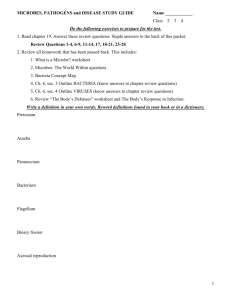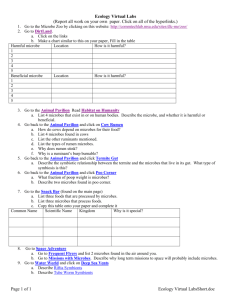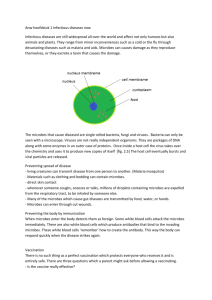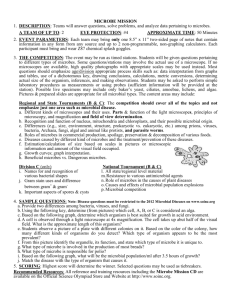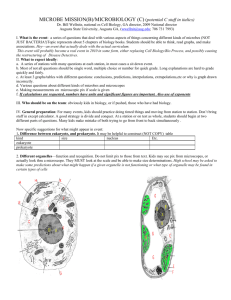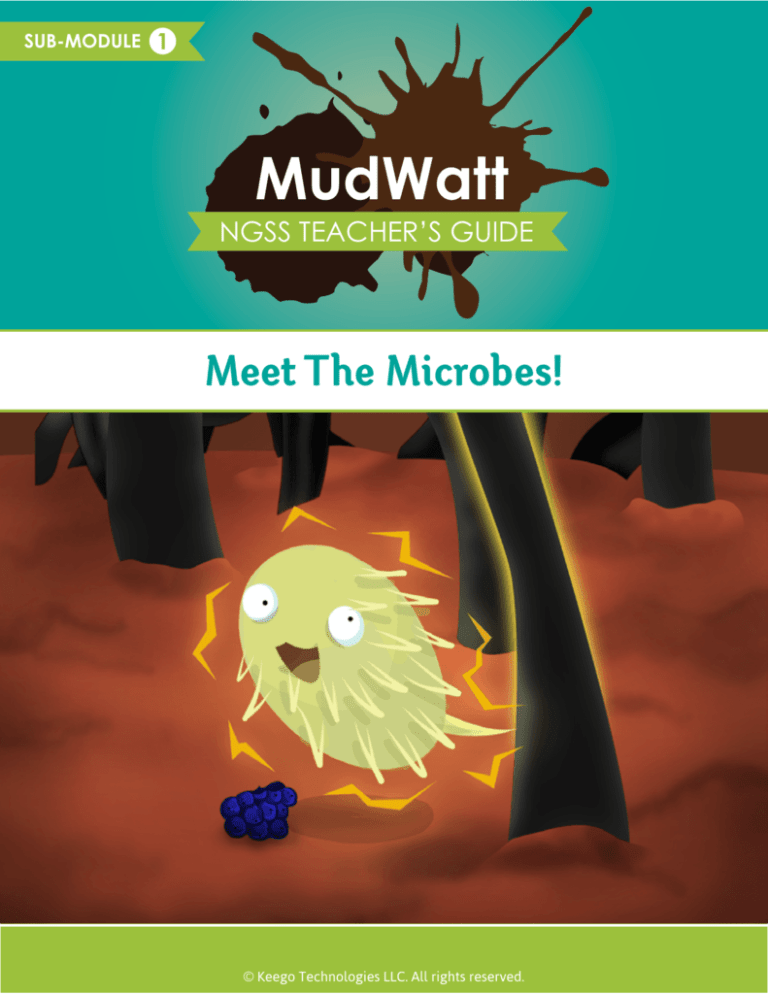
sub-module
1
mudWatt
NGSS Teacher’s Guide
Meet The Microbes!
© Keego Technologies LLC. All rights reserved.
Table of Contents
Table of Contents
1
Introduction2
Learning Objectives
Essential Questions
By The End of This Lesson...
NGSS Alignment
Vocabulary
2
2
2
3
4
Pre-Assessments5
Pre-Assessment Method 1: Free Response
Pre-Assessment Method 2: Multiple Choice
5
6
Background7
The Good, The Bad and The Ugly!
What Do Microbes Look Like?
10
11
Student Activities
Activity 1: How Big Are Microbes?
Activity 1: Relative Size Chart
Activity 1: Images
Activity 2: Make A Microbe!
Activity 2: Student Handout A: What Are Microbes?
Activity 2: Student Handout B: Microbe Trivia
Activity 2: Student Handout C: Make Your Microbe
Activity 3: Extremophile Profile
Activity 3: Research Notes Sheet
Activity 3: Extremophile Profile
12
12
13
14
15
16
17
18
19
20
21
References22
Sub-Module 1 | Meet The Microbes!
Table of Contents
1
Introduction
Learning Objectives
Students are introduced to the idea that microbes exist virtually everywhere,
even in extreme environments, and that some microbes are beneficial while
others are harmful to other organisms or the environment.
Essential Questions
1. What is a microbe?
2. Are microbes good/beneficial or bad/harmful?
3. What do microbes look like?
How big are microbes?
Student Activity: How big are microbes?
4. What shape are microbes?
Student Activity: Make a Microbe
5. Where do microbes live?
Extremophiles
Student Activity: Extremophile Wanted Poster
By The End of This Lesson...
Students will understand that:
• Bacteria, viruses and fungi are three different types of microbes
• Microbes are found virtually everywhere
• Many microbes live in extreme environments
• Microbes have both positive and negative impacts on humans, other
organisms, and the environment
Students will be able to:
• Define what a microbe is
• Use distinguishing characteristics to differentiate between bacteria,
viruses and fungi
• Identify positive and negative attributes of microbes
• Explain how microbes are a crucial part of our daily life
Sub-Module 1 | Meet The Microbes!
Introduction
2
Introduction
NGSS Alignment
core ideas
Core Idea LS1: From Molecules to Organisms: Structures and Processes
LS1.A: Structure and Function
Core Idea LS2: Ecosystems: Interactions, Energy, and Dynamics
LS2.B: Cycles of Matter and Energy Transfer in Ecosystems
cross cutting concepts
Patterns
55 Cause and effect: Mechanism and explanation
Scale, proportion, and quantity
Systems and system models
55 Energy and matter: Flows, cycles, and conservation
Structure and function
Stability and change
practices
55 Asking questions (for science) and defining problems (for engineering)
Developing and using models
Planning and carrying out investigations
Analyzing and interpreting data
Using mathematics, information and computer technology, and
computational thinking
55 Constructing explanations (for science) and designing solutions (for
engineering)
55 Engaging in argument from evidence
Obtaining, evaluating, and communicating information
Sub-Module 1 | Meet The Microbes!
Introduction
3
Introduction
Vocabulary
Microbe
Bacteria
Microscopic
Fungi
Macroscopic
Virus
Sub-Module 1 | Meet The Microbes!
Extremophile
Introduction
4
Pre-Assessments
Pre-Assessment: Free Response
Ask students to write down their ideas on the following questions using only what
they already know:
1. What is a microbe?
2. What are germs?
3. What do you think microbes look like? Draw a picture to go with your answer:
4. Where are microbes found?
5. In what ways can microbes be good/beneficial to other living organisms?
6. In what ways can microbes be bad/harmful to other living organisms or the
environment?
7. What questions do you have about microbes?
Sub-Module 1 | Meet The Microbes!
Pre-Assessments
5
Pre-Assessments
Pre-Assessment: Multiple Choice
Ask students to answer the following questions using only what they already know:
1. The term “Microbes” refers to __________________
a. Bacteria
b. Fungi
c. Protozoa
d. All of the above [i.e. it’s another term for “microorganism”]
2. Microbes are ____________ humans and other organisms
a. good for
b. bad for
c. good or bad for (depends on the type of microbe)
3. Microbes are important to the environment because they
a. act as a food source for larger organisms
b. break down dead organisms and waste
c. clean up toxic waste sites
d. all of the above
4. What scale would be best to measure the size of microbes?
a. meters
b. centimeters (hundredths of a meter)
c. millimeters (thousandths of a meter)
d. micrometers (millionths of a meter)
e. nanometers (billionths of a meter)
True or False:
5. All microbes carry disease and cause people to be sick
TRUE FALSE
6. Microbes are on your skin and in your body TRUE FALSE
7. Microbes only live in dead organismsTRUE FALSE
8. Microbes only live in soil TRUE FALSE
9. Microbes can only grow in darkness TRUE FALSE
10. Microbes can only live if oxygen is presentTRUE FALSE
11. Microbes can only live in temperatures between 0º- 80 º C
Sub-Module 1 | Meet The Microbes!
TRUE FALSE
Pre-Assessments
6
Background
What is a microbe?
The term microbe, short for microorganism, is used to
describe any tiny organism that is too small individually to
be seen with the naked eye. To see a microbe you need to
use a powerful microscope. Microbes get a bad rap – yes,
microbes can cause disease or illness, but microbes are also
essential players in the recycling of nutrients and in making
it possible for Earth to sustain life! There are three main
types of microbes: bacteria, fungi and viruses.
https://www.flickr.com/photos/kaibara/2234750993/
Bacteria
To many people when they hear the term bacteria they
think only of “germs,” invisible organisms that can
make us sick. In reality, bacteria are quite important,
essential in fact, to the lives of many organisms,
including humans, and to the health of our planet.
Photo by PeskyPlummer (Own work) [CC BYSA 3.0 (http://creativecommons.org/licenses/
by-sa/3.0)], via Wikimedia Commons
They help with food digestion, decomposition of
organic material including garbage, and even help
provide essential life sustaining materials including
oxygen, upon which so many organisms depend.
Bacteria consist of only a single cell, but don’t let
their small size and seemingly simple structure
fool you. They are amazingly complex and diverse
microorganisms that exist virtually everywhere.
Did you know there millions, no – billions of microbes
in and around you right now? There are more of
them on a person’s hand than there are people on the entire planet! Microbes are
even inside of us. Did you know that for every human cell in your body there are 10
microbes!! That means that you are more microbe than human!!
Bacteria have been found living in every imaginable type of environment, even those
thought to be uninhabitable. They have been found in water, soil, ocean sediments
and air. They are capable of living in temperatures that exceed the boiling point of
water (>100ºC or 212ºF) and in temperatures so cold that it would freeze your blood.
Bacteria have also been found in acid volcanoes and under extremely high pressure
at the bottom of the ocean. There’s even a species of bacteria that can withstand
blasts of radiation 1,000 times greater than a human being can withstand. They
Sub-Module 1 | Meet The Microbes!
Background
7
Background
“eat” everything from sugar and starch to sulfur and iron and produce 70-80% of the
oxygen in our atmosphere!
Some bacteria are able to reproduce rapidly – doubling in numbers in as little as 20
minutes, while some bacteria can survive in a resting stage for centuries. Each square
centimeter of your skin averages about 100,000 bacteria. In natural waters (lakes,
streams, oceans) there are approximately 1 million (106) bacteria in every 1 mL of
water on the surface of the Earth, and approximately a billion (109) bacteria in every
ml (cm3) of soil and sediments.
Fungi
Photo: http://upload.wikimedia.
org/wikipedia/commons/2/2c/
Spizellomycete.jpg
Fungi are a group of organisms that can range in size from a
microscopic single cell (eg, yeasts) to enormous macroscopic
chains of cells that can stretch for miles. Fungi may look like
plants, but most cannot produce their own food from soil
and water. Instead, they live off other animals and plants.
Fungi are one of the few types of organisms capable of
breaking down the strong structural material found in plants
called cellulose and lignin.
Fungi grow in the form of a finelybranched network of strands
called hyphae which are 5-10 μm in diameter. These
hyphae release digestive enzymes and are able to absorb
nutrients. Fungi are only capable of absorbing small
molecules like glucose (a simple sugar) which is produced
when the cellulose is broken down by the digestive
enzymes. Fungi are most commonly found on land, and
are rare in aquatic environments. On land, the amount of
hyphae in the soil is measured in hundreds or thousands
of meters of length per gram of soil. For example, the total
length of hyphae in a gram of soil (about the amount that
would fit on the fingernail of your little finger) can reach up
to 1,600 meters!
Photo: http://commons.wikimedia.
org/wiki/File:Flammulina_velutipes.
JPG
Viruses
Viruses are the simplest and tiniest of microbes. Viruses themselves are not actually
alive. They are unable to metabolize or reproduce unless they are inside another
living cell, or “host”. They can be as much as 10,000 times smaller than bacteria. They
consist of genetic material (DNA or RNA) surrounded by a protective protein viral
Sub-Module 1 | Meet The Microbes!
Background
8
Background
coat, called a capsid. When viruses come into contact with
living cells they “take over” the host cell. The virus triggers
the host cells to engulf them, or they fuse themselves to the
cell membrane of the host so they can release their DNA
into the cell.
Once inside a host cell, viruses take over the machinery
to reproduce. Viruses override the host cell’s normal
functioning with their own set of instructions. These
instructions shut down production of host proteins and
direct the cell to produce viral proteins to make new virus
particles.
Sub-Module 1 | Meet The Microbes!
By NIAID (HIV-infected T cell) [CC
BY 2.0 (http://creativecommons.
org/licenses/by/2.0)], via Wikimedia
Commons
Background
9
Background
The Good, The Bad and The Ugly!
Helpful
Bacteria
Fungi
Viruses
Harmful
Allow milk to be turned into cheese,
yogurt, and other dairy products
while bacteria in our digestive
systems help digest food and
produces Vitamin K. Photosynthetic
bacteria that live in water produce
large amounts (70-80%) of the
oxygen in our atmosphere, while
certain soil bacteria are able to
convert free nitrogen (Nitrogen gas,
N2) into a form that plants can use
to grow. There are even bacteria
in soil, sediments and wastewater
that give off electrons which can be
used to generate electricity!
Cause illness and disease such as
tuberculosis, staph infections, strep
throat, meningitis, pneumonia, and
food poisoning.
Fungi are responsible for breaking
down dead organic material, which
helps recycle nutrients. Soil fungi
have also been used to develop
important drugs, such as penicillin,
and other antibiotics.
Cause a number of diseases in
animals (ringworm and athlete’s
foot in humans), and in plants (rusts,
smuts, and leaf, root, and stem rots).
We tend to think of all viruses as
bad for the host organism but there
are some bacteria that are actually
beneficial to the host organism such
as: one type of soil bacteria - has
viral genes that help protect it from
heavy metals and other harmful
substances in the soil.
Cause many commonly known
diseases: smallpox, the common
cold, chickenpox, influenza, shingles,
herpes, polio, rabies, Ebola, and the
Human Immunodeficiency Virus
(HIV). It is also thought that cervical
cancer may be caused by the Human
papillomavirus. There are vaccines
against many viral diseases.
Sub-Module 1 | Meet The Microbes!
Background
10
Background
What Do Microbes Look Like?
Bacterial microbes come in many different shapes but the most basic shapes are:
Round
Rod
Spiral
(coccus)
(bacillus)
(spirillum)
http://www.ppdictionary.com/bacteria/bacteria_sizes.jpg
Sub-Module 1 | Meet The Microbes!
Background
11
Student Activities
Activity 1: How Big Are Microbes?
Microbes are too small to see with an unaided eye and therefore it is difficult
to gain perspective of their size. In this activity you will make a scale model
showing the relative sizes of viruses and bacteria in comparison to a human
blood cell and a human hair.
(Adapted from: http://www.microbeworld.org/microbeworld-experiments/lets-get-small)
Time: 50 minutes
Materials:
• Metric ruler or meter
stick
• Access to large,
open area (field,
gymnasium, empty
parking lot)
• Magnifying glass
• Activity 1: Relative
Size Chart
• Pictures of human
hair, human red
blood cell, bacterium,
virus (use those
provided in
Activity 1: Images or
find/draw your own)
Procedure
1. Examine an actual human hair with and
without magnification.
2. Using the information in the Relative Size
Chart, mark off a distance equal to the width
of a human hair. Place an image of a human
hair at this distance.
3. Repeat this process, measuring and marking
the scale distances representing the
diameter of a human red blood cell, the size
of a bacteria and the size of a virus.
Questions
1. List in order of increasing size: bacteria,
virus, human red blood cell, human hair.
2. How much bigger is a bacterium than a
virus?
(Approximately how many times bigger is a bacterium
than a virus?)
3. How much bigger is a human red blood cell
than a bacterium?
(Approximately how many times bigger is a human
red blood cell than a bacterium?)
4. Why do we need to make a model to show
the relative sizes of these objects instead of
simply looking in a microscope?
(Explain the benefits of using a model.)
Sub-Module 1 | Meet The Microbes!
Student Activities
12
Student Activities
Activity 1: Relative Size Chart
Human hair
(width)
Human red blood cell
(diameter)
Bacteria
Virus
Actual Size
Scale Size
0.1 mm wide
10 m
10.0 μm
1m
(0.01 mm)
0.5-2.0 μm
(0.005-0.002 mm)
20-100 nm
(0.00002-0.0001 mm)
5-20 cm
2 – 20 mm
Key:
cm = centimeters (hundredth of a meter)
mm= millimeters (thousandths of a meter)
μm = micrometers (millionths of a meter)
nm = nanometers (billionths of a meter)
http://micro.magnet.fsu.edu/cells/images/cellsfigure1.jpg
Sub-Module 1 | Meet The Microbes!
Student Activities
13
Student Activities
Activity 1: Images
Human Hair
By Titus Tscharntke [Public domain], via Wikimedia Commons
Human Red Blood Cell
By Rogeriopfm (Own work) [CC BY-SA 3.0 (http://creativecommons.org/
licenses/by-sa/3.0) or GFDL (http://www.gnu.org/copyleft/fdl.html)], via
Wikimedia Commons
Bacterium
Virus
http://upload.wikimedia.org/wikipedia/commons/thumb/5/5a/Average_prokaryote_cell-_en.svg/1258px-Average_prokaryote_cell-_en.svg.png
http://www.sholtoainslie.com/wp-content/uploads/2013/03/VirusStructure1.
jpg
Sub-Module 1 | Meet The Microbes!
Student Activities
14
Student Activities
Activity 2: Make A Microbe!
In this activity students will view different types of microbes using images
provided (Student Handouts A and B). They will use their understanding of
what microbes look like to create a microbe out of clay. Each student will
decide whether their microbe is useful or harmful and should create a name
for their microbe.
Students will present their microbes to the class and should explain what
features were selected and why they were chosen. Students should also be
able to explain whether the microbe is helpful or harmful to humans or other
organism.
Time: 1 class period
Materials:
• Images of microbes
• Petri dishes
• Clay (many colors)
• Student Handout A:
What are Microbes? • Student Handout B:
Microbe Trivia
• Student Handout C:
Make Your Microbe
Student handouts adapted from
www.e-bug.eu.
Sub-Module 1 | Meet The Microbes!
“Polymer clay examples” by Dan Bollinger - Own work. Licensed under CC BY-SA 3.0 via
Wikimedia Commons - http://commons.wikimedia.org/wiki/File:Polymer_clay_examples.
jpg#mediaviewer/File:Polymer_clay_examples.jpg
Microbe images by www.e-bug.eu
Student Activities
15
Student Activities
Activity 2: Student Handout A: What Are Microbes?
What are microbes?
4. They are found EVERYWHERE!
1. Microbes are living organisms
(except for viruses).
5. Some microbes are useful or even
good for us.
2. They are so small we need a
microscope to see them.
6. Some microbes can make us ill.
3. They come in different shapes and sizes.
The 3 types of microbes in order of size:
Viruses
• Viruses are the smallest,
even smaller than bacteria,
and can sometimes live
INSIDE bacteria!
Bacteria
Spirals
Rods
• Viruses can spread from
one person to another but
it depends on the type of
virus.
• Fungi are the largest of all
microbes.
• Fungi can be found in the
air, on plants and in water.
• Some viruses make us sick.
• Diseases like chickenpox
and the flu are caused by
viruses.
Fungi
• Mold, which grows on bread,
is a type of fungus.
Campylobacter
Lactobacillus
Balls
• Some antibiotics are made
by fungi!
Staphylococcus
• They are so small that
1000’s of bacteria could fit
on the period at the end of
this sentence.
Influenza
Dermatophyte
• Some bacteria are helpful
in cooking, for example,
making yogurt and cheese.
• Some bacteria are harmful
and cause infection.
• Bacteria multiply very fast.
Penicillium
• There are three different
types of bacteria: spirals,
rods, and balls.
Handout adapted from www.e-bug.eu
Sub-Module 1 | Meet The Microbes!
Student Activities
16
Student Activities
Activity 2: Student Handout B: Microbe Trivia
There are 3 different types of microbe – bacteria, viruses and fungi. From the pictures
and descriptions below, can you work out which microbe is which?
Hint: Remember there are three types of bacteria: rods, spirals, and balls.
What kind of microbe am I?
I am round in shape and I like to live
in your nose or armpits! If I live on your
skin I can give you spots. If I get into
your bloodstream I can make you ill!
Staphylococcus
Influenza
My friends call me the “flu”. I’m
very generous; I like to give people
headaches and fever. I easily spread
from one person to another through
coughing and sneezing.
People call me “friendly” because I
change milk into yogurt! When you eat
me in yogurt, I live in your guts and help
you digest other food.
Lactobacillus
Penicillium
You’ll find me growing on old oranges
or stale bread making them look
moldy. Humans use me to make an
antibiotic known as Penecillin, which
can make them better, but only from
bacterial infections!
I like to live on your skin. I especially
like living in damp places like between
the toes on sweaty feet! When I live
there I give people athlete’s foot!
Dermatophyte
I have a pretty spiral shape and I like
to live in chickens but if I get into your
tummy I make you very ill – I can give
you diarrhea!
Campylobacter
Handout adapted from www.e-bug.eu
Sub-Module 1 | Meet The Microbes!
Student Activities
17
Student Activities
Activity 2: Student Handout C: Make Your Microbe
Design a microbe of your choice with what you’ve learned so far: either
a bacterium, a virus, or a fungus, using materials provided. Decide if your
microbe will be helpful or harmful.
Viruses
Bacteria
Fungi
Name Your Microbe: _______________________________
Helpful or Harmful? ________________________
Handout adapted from www.e-bug.eu
Sub-Module 1 | Meet The Microbes!
Student Activities
18
Student Activities
Activity 3: Extremophile Profile
In this activity students will explore some of the craziest places microbes
can be found. Students will conduct online research to gather information
about a specific extremophile (an organism that is able to survive in extreme
conditions). Using this information, students will create a ‘Profile Page‘ for
the extremophile. Students should be encouraged to be creative while still
being factual and accurate with the information.
Time: 1 class period
Materials:
• Internet for online
research
• Activity 3: Research
Notes
• Activity 3: Extremophile
Profile
Procedure
1. The teacher may assign or have students
choose one extremophile to research.
2. Students should research the Features,
Conditions, Geographic Location, Habitat,
Special Features, and Other Information
about their extremophile online and/or
with information provided in this lesson.
3. Students take notes on their
extremophile using one Activity 3:
Research Notes sheet per source.
4. Students should fill out the Activity 3:
Extremophile Profile Page about their
extremophile with the information they
gathered.
By William Waterway (water author/researcher/photographer) [CC BY-SA 3.0 (http://creativecommons.org/licenses/by-sa/3.0)], via Wikimedia Commons
Sub-Module 1 | Meet The Microbes!
Student Activities
19
Student Activities
Activity 3: Research Notes Sheet
Fill out one of these sheets for every different source used during research.
Extremophile Type:
Source of Information:
Extreme Environment:
Notes
Features
Detailed description of
appearance, shape size,
color, texture, etc.
Conditions
What is it like where these
organisms live? Describe the
environment (temperature,
salinity, pressure, acidity
ranges, etc.)
Geographic Location
Where on Earth are these
conditions found?
Habitat
Specific setting where your
organism is found (under a
rock, in shallow water, near
the shoreline, surrounded by
plants, etc.)
Special Features Special
adaptations that help them
survive in their extreme
environments (e.g., a coating
of mucous to neutralize the
acidity)
Other interesting
information
Sub-Module 1 | Meet The Microbes!
Student Activities
20
Student Activities
Activity 3: Extremophile Profile
Cover Photo of Extreme Environment
Profile Information
Profile Picture
Features
Conditions
Habitat
Extremophile Name
Extreme Environment
Special
Features
Geographic Location
Other
Interesting
Information
Sub-Module 1 | Meet The Microbes!
Student Activities
21
References
What is a microbe:
http://www.microbeworld.org
http://www.e-bug.eu/
http://www.ucmp.berkeley.edu/alllife/virus.html
Microbe size comparison:
http://www.microbeworld.org/microbeworld-experiments/lets-get-small
Resources for extremophile research:
http://www.edu.pe.ca/southernkings/microbacteria.htm
http://www.eeob.iastate.edu/faculty/DrewesC/htdocs/wantpost2.htm
http://serc.carleton.edu/microbelife/extreme/environments.html
http://www.physics.uc.edu/~hanson/ASTRO/LECTURENOTES/ET/S04/Life/
ExtremophilesChart.html
http://www.theguardians.com/Microbiology/gm_mbm04.htm
http://www.cosmonline.co.uk/category/image-galleries/natural-world
Curriculum by Karen Manning. Graphic Design by Stephanie Pan.
Sub-Module 1 | Meet The Microbes!
References
22




